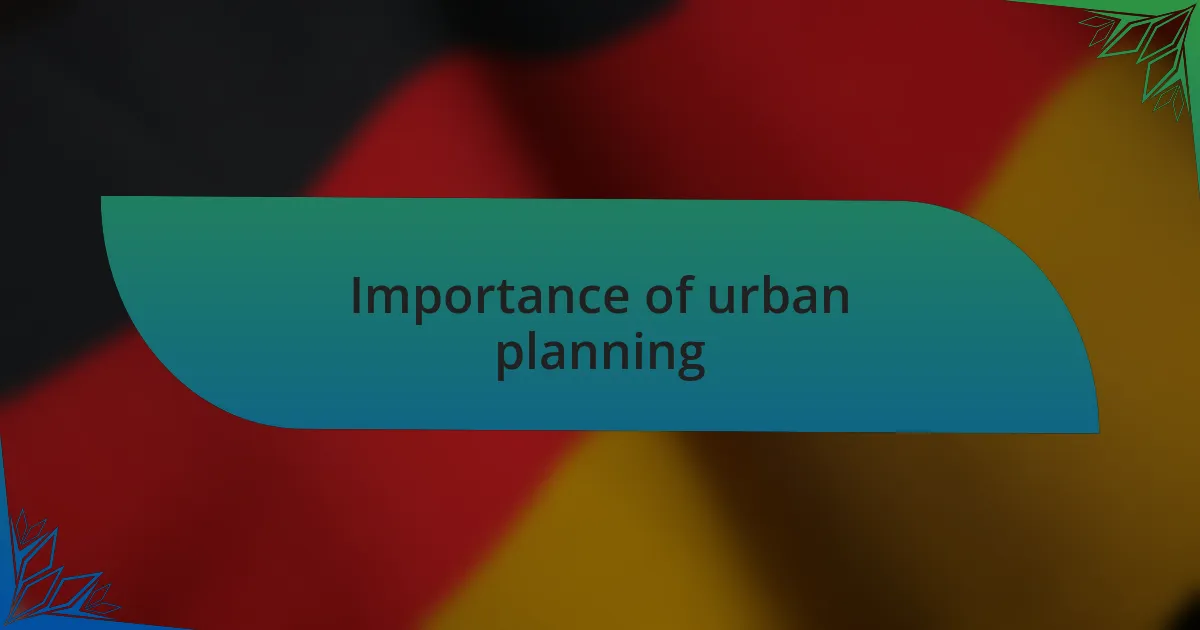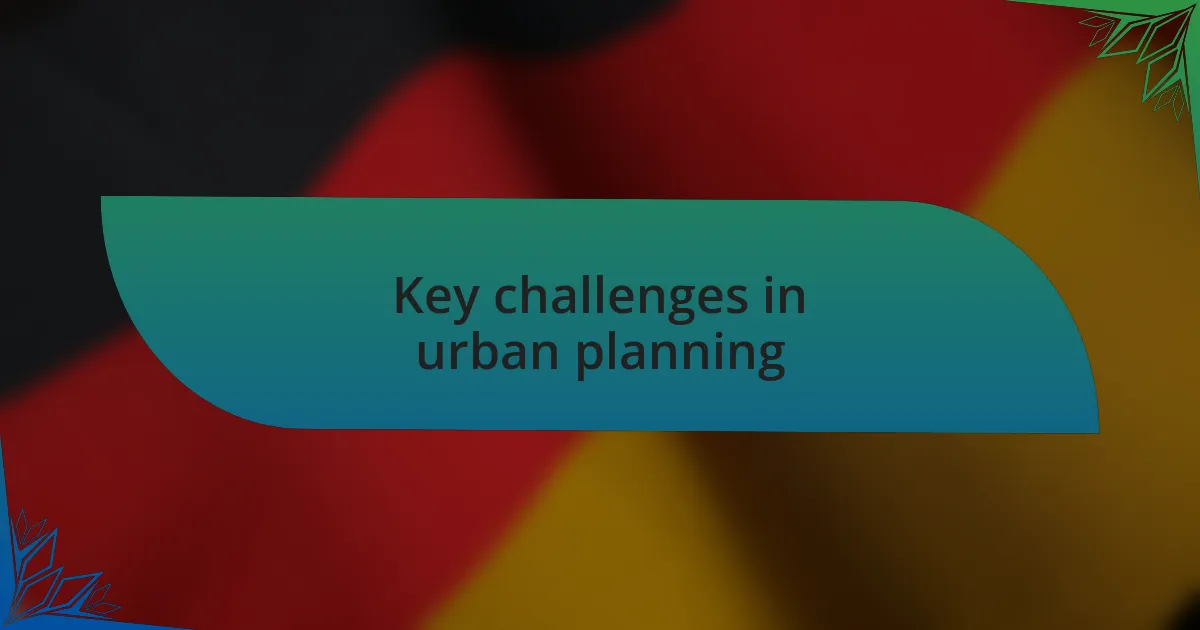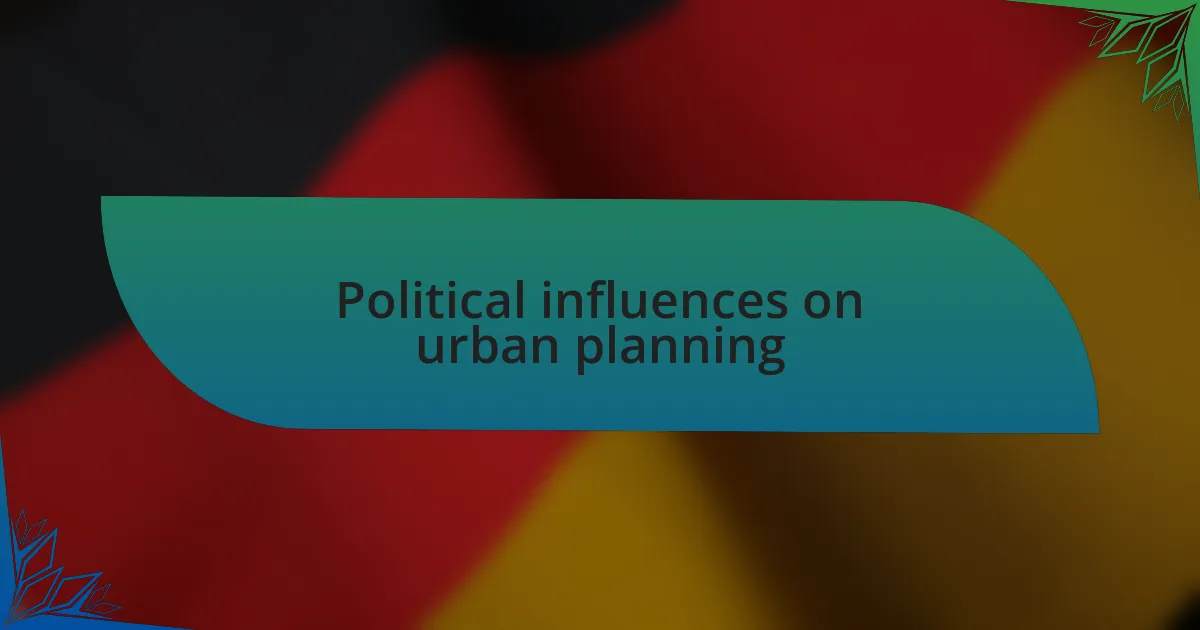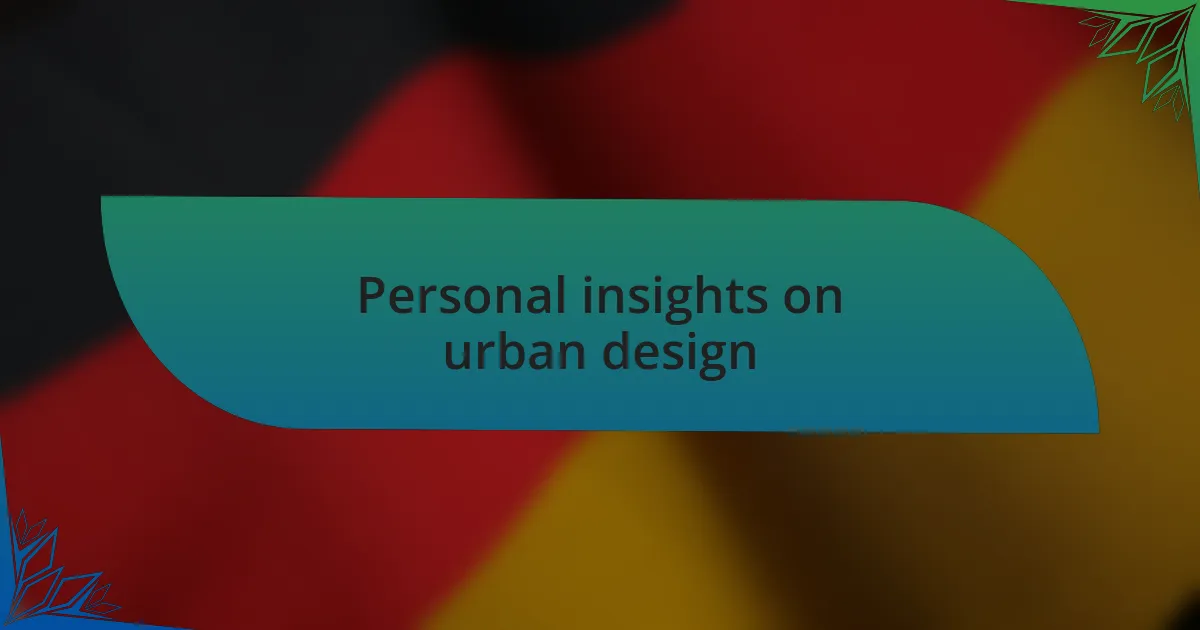Key takeaways:
- Urban planning significantly impacts community connectivity and daily life, emphasizing the importance of design in fostering interaction and well-being.
- Sustainable development and community engagement are essential to overcoming challenges in urban planning, addressing both environmental concerns and residents’ needs.
- Political influences complicate urban planning processes, highlighting the need for equitable policies that prioritize long-term community welfare over short-term interests.
- Future trends in urban planning focus on sustainability, technology integration, and mixed-use developments to enhance livability and connectivity in cities.

Understanding urban planning concepts
Urban planning is a fascinating blend of design, policy, and community needs. When I first stumbled upon this field, I was struck by how every decision made by urban planners can shape the lives of so many. Have you ever considered how a thoughtfully designed park can become a community hub, fostering connections among neighbors? I know from experience that these places transform not just landscapes but entire communities.
One key concept in urban planning is zoning, which dictates how land can be used. This type of regulatory framework might sound dry, but it is essential in managing urban growth. I remember attending a town hall meeting where zoning proposals were hotly debated; the passion in the room highlighted just how much people care about where they live and how they envision their neighborhoods. It made me realize that behind every zoning line is a story waiting to unfold.
Another intriguing aspect is the emphasis on sustainable development. I’ve seen firsthand the challenge of balancing growth with environmental concerns. I often ask myself: how can cities grow without erasing the very nature they depend on? The conversations I’ve had with local leaders have made it clear that sustainable urban planning is not just a buzzword—it’s crucial for securing a livable future for generations. The emotional investments people have in their environment can truly inspire meaningful change.

Importance of urban planning
Urban planning plays a vital role in shaping not just our cities but also our daily lives. I recall walking through a redesigned neighborhood where sidewalks were widened, making it safer for families to stroll around. In that moment, I realized the importance of designing spaces that promote walkability and encourage community interactions. How often do we undervalue the simple act of wandering through a vibrant street?
One of the most significant impacts of urban planning is its influence on public health. A few years ago, I attended a workshop where experts discussed how green spaces can significantly reduce stress levels and improve mental well-being. Can you imagine the difference a small park can make in a densely populated area? Simply knowing that a community prioritizes access to nature struck me as an essential aspect of urban planning that frequently goes unnoticed.
Additionally, effective urban planning can aid in mitigating socioeconomic disparities. I often think back to my time volunteering in a community development project, where enhancing access to public transport opened new job opportunities for residents. This realization hit home: thoughtful planning can break barriers and promote equity within urban settings. Isn’t it fascinating how the layout of our cities can create pathways for progress?

Key challenges in urban planning
One of the most pressing challenges in urban planning is the struggle with balancing growth and sustainability. I remember visiting a city that expanded rapidly without considering its environmental impact. The consequences were evident; air quality suffered, and urban heat islands formed. How can we prioritize development while safeguarding our environment? That question often lingers in my mind.
Another significant hurdle is the issue of community engagement. During a town hall meeting I attended, I observed a stark disconnect between city planners and residents. Many felt their voices were unheard, leading to mistrust in the planning process. It made me wonder: how can we foster genuine connections with communities to ensure their needs and preferences are truly integrated into urban designs?
Finally, the challenge of funding cannot be overlooked. I recall attending a discussion where local leaders expressed frustration over limited budgets. They lamented the impossibility of executing comprehensive urban plans without sufficient financial backing. How do we create thriving urban landscapes when resources are so constrained? This is a dilemma that requires innovative solutions to avoid stagnation in essential urban developments.

Political influences on urban planning
Political influences play a crucial role in shaping urban planning. I recall a meeting where local legislators discussed proposed zoning changes after a significant election. The urgency in their voices highlighted how political shifts can dictate land use decisions, often favoring developers at the expense of community needs. It begs the question: how can we ensure that elected officials prioritize the long-term welfare of our cities over short-term gains?
At another point, I attended a community board meeting where residents expressed concerns about new housing policies. Their frustration was palpable, as many felt these policies favored wealthy newcomers and overlooked the needs of long-term residents. This moment made me reflect on the ethical responsibilities that politicians hold in urban planning—a responsibility to create equitable cities that serve all, not just a select few. How can we cultivate a political climate that genuinely listens to and values its constituents?
In my experience navigating these discussions, I’ve noticed that political motivations often complicate consensus-building. For instance, during a public consultation on improving public transport, differing political agendas led to conflicting proposals. I couldn’t help but consider: when will we prioritize the collective good over partisanship? The answer seems increasingly vital as our urban landscapes evolve, and communities strive for inclusivity and accessibility.

Personal insights on urban design
There’s something deeply personal about experiencing urban design firsthand. I remember walking through a neighborhood where every block told a story—a park flourishing with families, an abandoned lot dreaming of revitalization. It made me ponder how thoughtful design can create spaces that foster community connection. Why do some areas feel alive while others feel neglected?
My heart resonates with the transformative power of spaces built for people, not just cars. During a recent visit to a redesigned downtown area, I felt a palpable shift in atmosphere; wider sidewalks and street art invited exploration and interaction. Yet, it left me questioning: are we truly listening to the voices that shape these designs? Community input often gets sidelined, which makes me wonder how many missed opportunities exist for enriching our urban experience.
I’ve often thought about the interplay between aesthetics and functionality. Growing up in a city that lacked green spaces, I yearned for parks where neighbors could gather. Now, as I observe urban planners integrating nature into design, I can’t help but feel hopeful. But I also worry—are these changes merely for show, or will they maintain accessibility for all residents? Urban design isn’t just about buildings; it’s about our collective life and how we interact with our environment.

Community engagement in urban projects
When I think about community engagement in urban projects, I recall a local town hall meeting I attended. It struck me how passionate residents were about sharing their vision for a new park. Their ideas—from enhanced lighting for safety to interactive art installations—could transform a simple space into a communal hub. Isn’t it fascinating how the most effective solutions often come straight from those who will use the spaces daily?
In another instance, I watched as a group of teenagers took the lead in designing a skate park. Their enthusiasm was contagious, and they conducted surveys to gather input from their peers. This collaboration not only empowered the youth but also fostered a sense of ownership in the community. It’s a reminder that engaging diverse voices can yield innovative outcomes that reflect the needs of everyone involved.
Reflecting on these experiences, I realize that successful urban projects require more than just expert opinion; they thrive on genuine dialogue. I often wonder what our cities could look like if we prioritized community voices at every stage of planning. Isn’t it worth investing time to ensure that every stakeholder feels heard? Such a commitment could redefine how we experience urban spaces, making them truly inclusive and vibrant.

Future trends in urban planning
As I explore future trends in urban planning, one notable shift is the move toward sustainability and green design. I remember visiting a city that integrated vertical gardens into its skyscrapers and created green roofs to combat urban heat. The air felt fresher and the atmosphere more inviting; how can we not embrace such innovations when they enhance urban living?
Another exciting trend is the incorporation of smart technology into city infrastructure. I once encountered a downtown area that used sensors to optimize street lighting based on pedestrian traffic. This not only saved energy but also made the streets safer at night. It prompts me to think: what other innovative solutions can technology provide to address urban challenges while improving quality of life?
Lastly, urban planners are increasingly recognizing the value of mixed-use developments—spaces that combine residential, commercial, and recreational areas. I’ve strolled through neighborhoods where one can live, work, and play all within walking distance, fostering a true sense of community. Is it possible that this holistic approach to city design could lead us toward happier, more connected urban experiences?